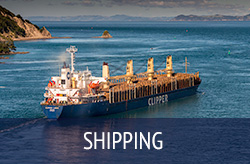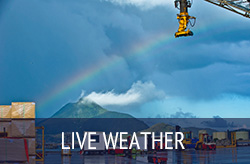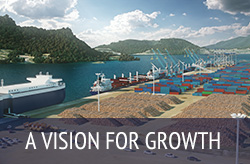Dynamic Under Keel Clearance

DYNAMIC UNDER KEEL CLEARANCE SYSTEM – MARSDEN POINT
Marsden Point operates a Dynamic Under Keel Clearance (DUKC) system, aiding in the safe transit of vessels to Northport and Refining NZ.
General Description
The DUKC system integrates real-time measurement of tide height and waves with modelled vessel motions in order to determine if a proposed transit for a particular vessel meets pre-determined under keel clearance safety criteria. The system uses specially formulated algorithms to analyse a range of inputs in order to provide a report as to the status of the proposed transit.
The DUKC System
The DUKC system is used to accurately predict a particular vessel’s under keel clearance (UKC) based on the vessel’s dimensions and stability, the prevailing environmental conditions, predicted vessel speeds and a detailed profile of the Whangarei Harbour approach channel.
Purpose of UKC
The DUKC system ensures that minimum levels of net UKC for vessel manoeuvrability and bottom clearance, for safe navigation in restricted waters, are always met or exceeded.
- Manoeuvrability Margin (MM) is set to ensure that there is sufficient water passing around the vessel’s hull and past the rudder for the vessel to be safely controlled. The MM limit is set depending on vessel type, channel configuration and whether the vessel has tug assistance.
- Bottom Clearance (BC) is set to ensure that the vessel does not touch the channel bed. The BC represents the minimum probable net UKC for a particular transit. The actual net UKC will always be greater than the BC value. The minimum limiting value for BC is set depending on the accuracy of predicting all other factors.
DUKC System Components
Automated inputs for environmental information are:
- Tidal data from the Marsden Point Tide Gauge
- Sea level information from the sea level monitoring station located on Frenchman Island
- Sea and swell data from the harbour entrance by two wave rider buoy's
Manual system inputs comprise:
- Hydrographic survey data
- Individual vessel information which is obtained from the completed “DUKC Vessel Particulars Request” form
Tidal Data is measured at the Marsden Point tide gauge. The DUKC system accounts for the difference between predicted and actual tides by allowing tidal residuals into its calculations. The tide level at the Whangarei Harbour shoal patch is subject to a 0.94 multiplier to account for a slightly lower tide level at the shoal patch in relation to Marsden Point.
Sea level information is derived from the two wave buoy's data via algorithm to detect the presence of long period swell waves. An allowance for ‘set down’ is made by the DUKC system when such waves are present.
Sea and Swell information is gathered by two wave rider buoy's located adjacent to the shoal patch at the Harbour entrance. The buoy's provide a spectral analysis of wave data, from which swell, wave direction, period and height can be ascertained for input into the DUKC calculations. The buoys transmit heir data every 30 minutes, with 27mins of recordings and 3 mints to transmit.
Hydrographic survey information for the whole approach channel is updated annually including the area of the shoal patch at the wave rider buoy.
Vessel information is manually input into the DUKC system. Vessel data is obtained prior to the vessel’s planned transit and used by the DUKC system to model the vessel’s movement during the proposed transit. The modelling accounts for vessel squat, bodily sinkage, change in trim, acceleration effects and models wave response.
Wave response modelling
In performing wave response modelling the system takes into account:
- Vessel stability in its current loaded condition (KG and GM);
- Vessel dimensions (LBP, beam and draft);
- Hull shape and displacement at the vessel’s transit draft;
- The effect of vessel speed and direction on incident wave frequency (Doppler Effect);
- The ratio of water depth and vessel draft and its effect on added mass and dampening;
- Incident angle of waves on the hull at different locations’ and
- The full range of wave periods that can induce vessel response.
Vessel wave response is calculated based upon the entered vessel characteristics and the most recent measured wave data. The maximum vertical hull displacement is calculated for the measured wave climate. This vertical displacement is subject to a multiplier to account for the highest possible wave that could be associated with the measured wave climate.
DUKC System Application
A manual calculation is performed on every vessel prior to transit to determine its Static UKC. Swell and Risaga (long wave) allowances used are for the sea conditions prevailing at the time of transit and together with a standard 0.9m safety margin they determine the required depth of water which is then compared to the available depth. The DUKC system is applied to all vessels that have a Static UKC of three metres or less when initial calculations are made. The DUKC system is also applied to vessels that have a Static UKC of greater than three metres when the weather and/or swell conditions are considered as having the potential to negate UKC for the proposed vessel transit. The application of the DUKC system may allow a ship to transit even though a manual calculation may otherwise prevent it.
Vessel Transits
The controlling depth in the approach channel is currently 14.6m at Chart Datum and is subject to change following annual hydrographic surveys. The tide height varies on any given day but can be obtained from the local tide tables but it is automatically fed into the DUKC system at the time of transit.
The authority to transit is based on the DUKC analysis of a vessel's loaded condition and weather conditions at the proposed real time of transit with computer calculations commencing not more than 30 hours prior to the vessel's actual intended transit time. Prior to entry the ship must supply stability data relevant to its loaded condition (DUKC Vessel Particulars Request Form) which is input into the DUKC computer software.
The computer software calculation, based on swell size and direction (obtained from the wave rider buoy), sea waves, long waves and tides (i.e. local conditions on any given day) and using the ship's relevant stability data supplied, will determine a green light for entry or a red light for non-entry at the proposed time of transit. The computer program provides allowances for the six degrees of vessel motion (i.e. heave, roll, pitch, sway, surge and yaw) for the sea conditions prevailing at the time of entry. When all the allowances have been applied and there is a bottom clearance of more than 0.4m, the report will give a GO for berthing. This is assessed for each and every transit from the first opportunity when the vessel arrives in the port roads until she meets the DUKC requirements based on the loaded draft and weather/swell conditions at the time.
Maximum Transit Drafts
The DUKC system cannot pre-determine the maximum transit draft as the swell conditions for the time of intended transit will be unknown until the actual time of transit. North Tugz is unable to predict the swell conditions for the time of transit but in general terms a ship with a greater draft has a narrower berthing window in marginal swell conditions than a ship with a shallower draft.
The maximum draft that a ship loads to for arrival at Marsden Point is a matter to be decided between the ship and its charterers. A few vessels have been loading to deeper drafts (approximately 14.5m / 14.7m maximum) but have been waiting at anchor, sometimes for up to a week for windows of opportunity based on favourable weather/swell conditions, before being able to berth.
Disclaimer
This information is provided without prejudice, Northport and North Tugz will not be liable for the way the information is used nor for any errors or omissions in its detail.






.JPG)




